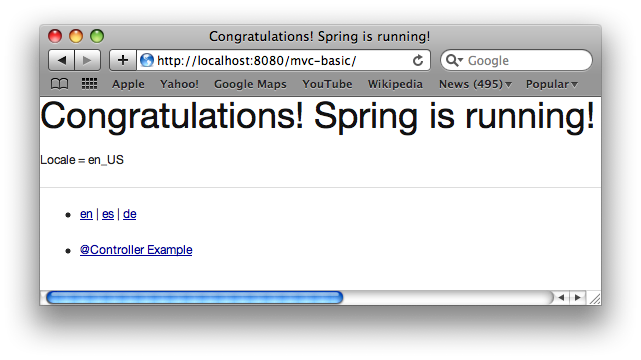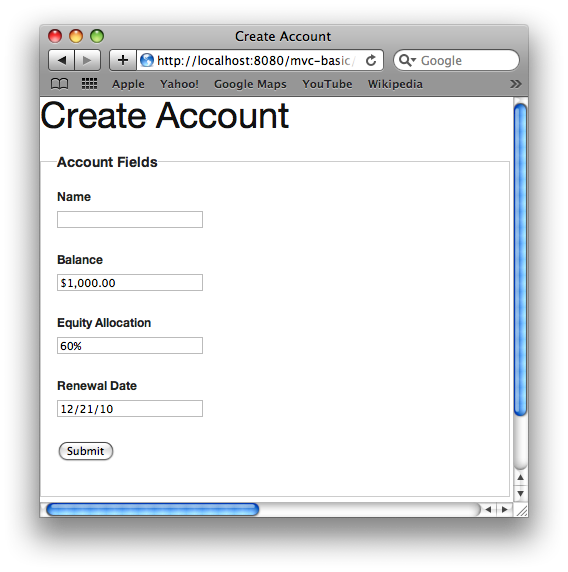Get ahead
VMware offers training and certification to turbo-charge your progress.
Learn moreAs Juergen and Arjen have mentioned, Java developers everywhere have a smooth upgrade with Spring 3.0. Now that Spring 3 is out, I'd like to take you through some of the new MVC features you may not know about. I hope you find these features useful and can start putting them to work in your web applications immediately.
This is also the start of a series on "Spring 3 Simplifications", so expect more posts like these in the coming days and weeks.
Spring 3 introduces a mvc namespace that greatly simplifies Spring MVC setup. Along with other enhancements, it has never been easier to get Spring web applications up and running. This can be illustrated by the mvc-basic sample, which I will now walk you through.
mvc-basic has been designed to illustrate a basic set of Spring MVC features. The project is available at our spring-samples SVN repository, is buildable with Maven, and is importable into Eclipse. Start your review with web.xml and notice the configuration there. Notably, a DispatcherServlet is configured with a single master Spring configuration file that initializes all other application components. The DispatcherServlet is configured as the default servlet for the application (mapped to "/"), allowing for clean, REST-ful URLs.
Inside the master servlet-context.xml, you'll find a typical setup. On the first line, component scanning has been turned on to discover application components from the classpath. On the next line, you'll find the first new Spring MVC 3 feature in action:
<!-- Configures the @Controller programming model -->
<mvc:annotation-driven />
This tag registers the HandlerMapping and HandlerAdapter required to dispatch requests to your @Controllers. In addition, it applies sensible defaults based on what is present in your classpath. Such defaults include:
Moving on, the next line demonstrates another new feature:
<!-- Forwards requests to the "/" resource to the "welcome" view -->
<mvc:view-controller path="/" view-name="welcome" />
Behind the scenes, mvc:view-controller registers a ParameterizableViewController that selects a view for rendering. In this case, when "/" is requested, the welcome view is rendered. The actual view template is a .jsp resolved inside the /WEB-INF/views directory.
Moving on, the next line shows yet another new feature:
<!-- Configures Handler Interceptors -->
<mvc:interceptors>
<!-- Changes the locale when a 'locale' request parameter is sent; e.g. /?locale=de -->
<bean class="org.springframework.web.servlet.i18n.LocaleChangeInterceptor" />
</mvc:interceptors>
The mvc:interceptors tag allows you to register HandlerInterceptors to apply to all controllers. Previously, to do this you had to explicitly register such interceptors with each HandlerMapping bean, which was repetitive. Also note this tag now lets you restrict which URL paths certain interceptors apply to.
Moving on, the next line hightlights a new feature added in version 3.0.4:
<!-- Handles GET requests for /resources/** by efficiently serving static content in the ${webappRoot}/resources dir -->
<mvc:resources mapping="/resources/**" location="/resources/" />
The mvc:resources tag lets you configure a handler for static resources, such as css and javascript files. In this case, requests for /resources/** are mapped to files inside the /resources directory.
Putting things in motion, if you deploy the sample you should see the welcome view render:

Feel free to activate the different language links to have the LocaleChangeInterceptor switch the user locale.
The next set of new features I'll illustrate pertain to @Controller binding and validation. As I blogged about a few weeks ago, there is a lot new in this area.
In the sample, if you activate the @Controller Example link the following form should render:

From there, if you change the locale you should see internationalized field formatting kick in. For example, switching from en to de would cause the Renewal Date 12/21/10 to be formatted 21.12.10. This behavior and the form's validation rules are driven by model annotations:
public class Account {
@NotNull
@Size(min=1, max=25)
private String name;
@NotNull
@NumberFormat(style=Style.CURRENCY)
private BigDecimal balance = new BigDecimal("1000");
@NotNull
@NumberFormat(style=Style.PERCENT)
private BigDecimal equityAllocation = new BigDecimal(".60");
@DateTimeFormat(style="S-")
@Future
private Date renewalDate = new Date(new Date().getTime() + 31536000000L);
}
Form submit is handled by the following AccountController method:
@RequestMapping(method=RequestMethod.POST)
public String create(@Valid Account account, BindingResult result) {
if (result.hasErrors()) {
return "account/createForm";
}
this.accounts.put(account.assignId(), account);
return "redirect:/account/" + account.getId();
}
This method is called after binding and validation, where validation of the Account input is triggered by the @Valid annotation. If there are any validation errors, the createForm will be re-rendered, else the Account will be saved and the user will be redirected; e.g. to http://localhost:8080/mvc-basic/account/1.
For an illustration of another cool new feature, try requesting an account that does not exist; e.g. /account/99.
Spring 3 is a great release containing numerous new features and simplifications across many exciting areas. I hope you found this post on some of the new Spring MVC enhancements useful. As I mentioned at the top, expect more to come in the "Spring 3 Simplifications" series, where we will continue to show new and interesting things you can do with the latest version of the framework.
Happy Holidays!